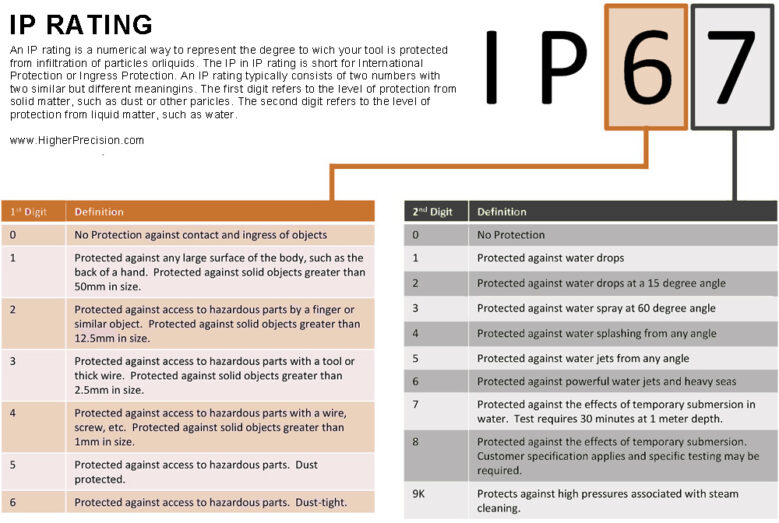To cut to the chase, you should always know the IP rating of a gage you are purchasing because it will directly impact how and when you use the gage and ensure you are making the correct purchase. But let’s take a step back—what is an IP rating anyway? IP stands for “International Protection” or “Ingress Protection.” An IP rating is the degree to which a gage is protected from particles, dust, and water entering the device. Knowing the amount of protection your gage has will help you determine whether it is appropriate for the operating environment that you require.
The standard IP rating consists of two digits, each with a specific meaning and value. The first digit in the pair refers to protection from solids. This can include dust, sand, dirt, or any other particles small enough to potentially penetrate your gage and damage the device. The numbers range from 0 to 6, with higher numbers representing higher levels of protection. The individual items of the scale include: 0 = No protection, 1 = Protected against touch by hands, 2 = Protected against touch by fingers, 3 = Protected against tools and wires, 4 = Protected against tools and small wires, 5 = Limited dust ingress protection, and 6 = Total dust ingress protection. Similar but different, the second digit refers to the amount of protection against the ingress of liquids. This scale includes numbers ranging from 0 to 8, with higher levels of protection depicted by higher numbers. The meaning of each of the items in the scale are: 0 = No protection, 1 = Protected against condensation, 2 = Protected against water spray < 15 degrees from vertical, 3 = Protected against water spray < 60 degrees from vertical, 4 = Protected against water spray from any direction, 5 = Protected against low pressure water jets from any direction, 6 = Protected against high pressure water jets from any direction, 7 = Protected against temporary immersion to at least 1m from bottom and 15cm from top of object, and 8 = Protected against continuous immersion to a specified depth or pressure.
Now, the important part. IP ratings serve 3 crucial functions: 1) to keep peoples’ hands and fingers from touching the interior of the device and hurting the gage or hurting themselves, 2) to keep solid objects or particles from getting into the gage, and 3) to protect the gage from ingress of liquids. The essence of an IP rating is protection from potential threats. The degree of risk that your device is in depends entirely on the reason you are using it and the context in which it will be used. If you purchase a gage without an IP rating, you are putting you, your device, and your job at risk of failure.
The determining factor for what IP rating you require comes down to the application of your device. Where will your gage be located and what is it doing there? Start by thinking just about the general setting and what obvious sources exist that could lead to exposure to dust or water. Then, you have to think ahead to any unexpected scenarios that might arise. Could there be any pipes in the area that could leak or break? Is there a sink or container in the area that could possibly overflow? How regularly is the area cleaned where the gage will be? How will the cleanliness of the site change over time? Will the surrounding work in the presence of the gage result in stray particles or condensation? Spend some time thinking of all possible scenarios that could present a risk to your gage. Then, based on this analysis decide the level of risk that is appropriate and the level of protection you are aiming to have. No matter what your specific precision measurement field or the particular job you need a gage for, the golden rule is to know the IP rating of the gage you purchase. Not knowing this information puts you at risk of ruining a project and wasting your money. Protect yourself with the IP rating information.

